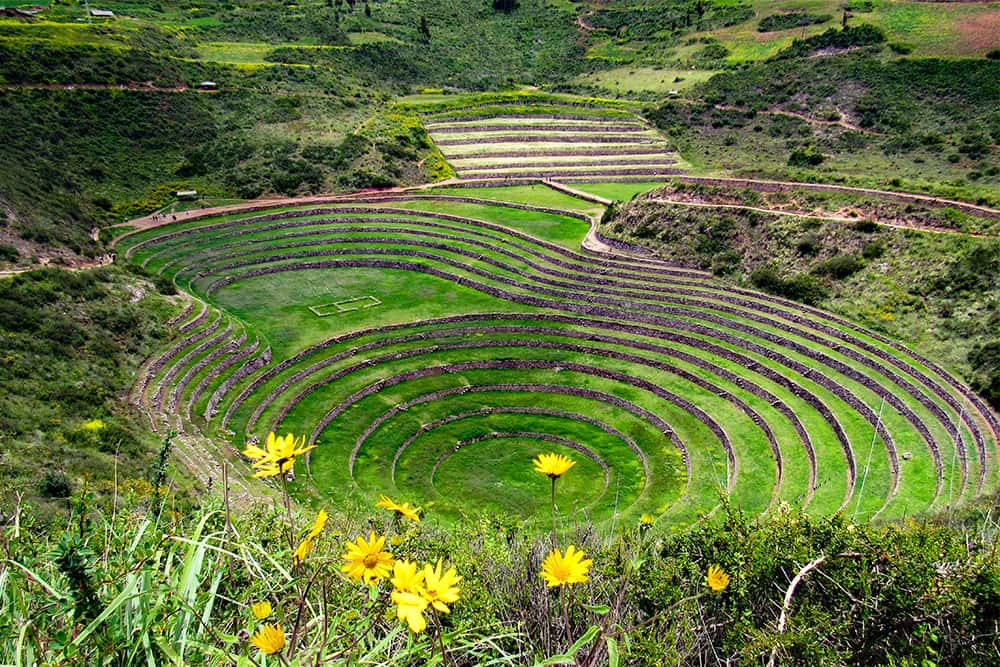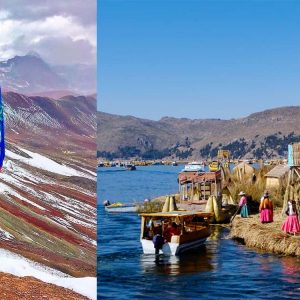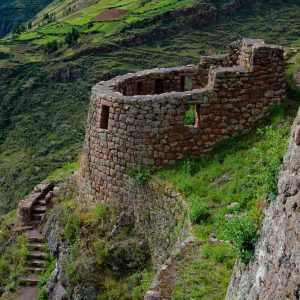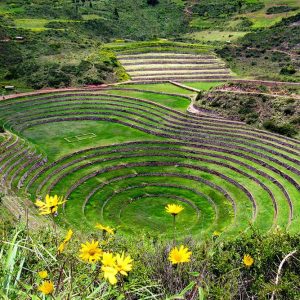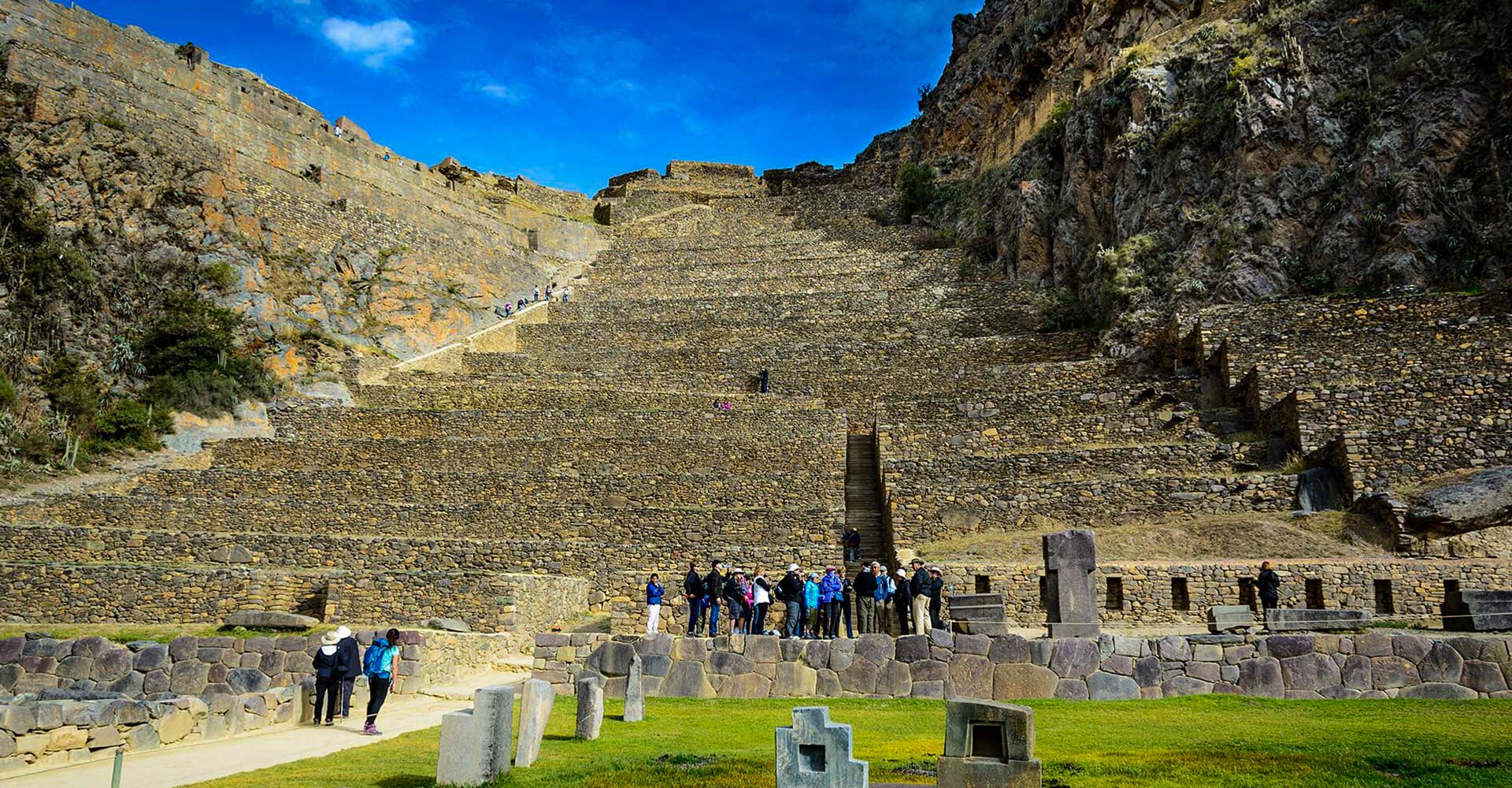
About the Sacred Valley
Tour of the Sacred Valley of the Incas also known as “Valle Sagrado” starts outside of Cusco in the town of Pisac. It stretches from Pisac all the way to Ollantaytambo, nestled between Cusco and the Majestic Machu Picchu. The valley is formed by the Urubamba River also known as the Volcanota River. It’s flanked by two prominent mountain peaks, Sahuasiray (elevation: 5,818m/19,088ft) in Calca and Veronica Mountain (elevation: 5,893m/19,334ft) in Ollantaytambo.
This Valley was the center of Tahuantinsuyo, the largest known empire in the Western Hemisphere. It spanned from Colombia and Ecuador, passing through Peru and Bolivia, to the northern part of the nations of Argentina and Chile. Its capital is the city of Cusco, which was known as the “navel of the world.” The sacred valley has always been an agricultural hub and still remains so. Its location and climate create the perfect spot for cultivation. The lower parts of the valley are warm and the top of the hills are cooler. Creating the ideal spot to preserve the crops and they have a constant supply of water from the many streams that flow into the valley from melting ice from the surrounding mountain peaks.
Agriculture
The Sacred Valley has a moderate climate and fertile land, which is the perfect combination for agriculture in the region. They produce maize,(corn) and lots of fruits and vegetables, and potatoes for exporting and self-consumption. This produce is usually sold in their many local markets and can be bought for cheap. The Incas cultivated potatoes, white corn, coca, fruits and vegetables, on terraces that can be seen decorating the mountain sides throughout the villages. Today the valley produces lucuma, peach, avocado, and one of the best corn varieties in the world.
Religion and Cosmology
The Sacred Valley was more than just an important agricultural center. The Urubamba River Valley, “Willcamayu” for the Incas, was one of the most important elements in the religious cosmology of the Incas. They believed that the flow of the Urubamba was closely linked to constellations and mountains. They also believed that it was the counterpart of the Milky Way on earth.
Tourism today
This region is the center of experiential tourism because of the many indigenous small towns you find along the way to Machu Picchu. You get to immerse yourself in their way of life and also visit long standing, ancient and historical Inca sites. It is regarded as the epicenter of adventure tourism, with different types of extreme sports to partake in. The best towns to visit include Chinchero, Pisac, Calca, Urubamba, Salinas, Moray and Ollantaytambo. It’s the gateway to Machu Picchu, the most visited archeological site in the world.
Weather in the Sacred Valley
The Sacred Valley of the Incas is 2,800m/9,186ft, 600 meters below Cusco, and enjoys one of the best climates in the region, daytime temperatures vary between 19°C/66°F and 24°C/75°F. This advantageous climate made the Incas use it as their main center of agricultural production, experimentation and research. Nowadays, travelers use the valley to acclimatize themselves, before starting their tours from Cusco through to Machu Picchu. Without a doubt, it is one of the best ways to avoid altitude sickness. While acclimatizing we recommend you stay at the Veronica View Hotel, and explore its nearby Incan sites with a “boleto turistico”.
Where is the Sacred Valley of the Incas?
The Urubamba river valley or “Sacred Valley of the Incas”, is located 15 km northeast of the city of Cusco and is reachable by a paved road. A trip by car to one of the nearest villages will take around 40 minutes. From there you can move to the other villages in the valley by local transport or you can book a classic Sacred Valley Tour, which will take you to all the important parts of the valley in one day.
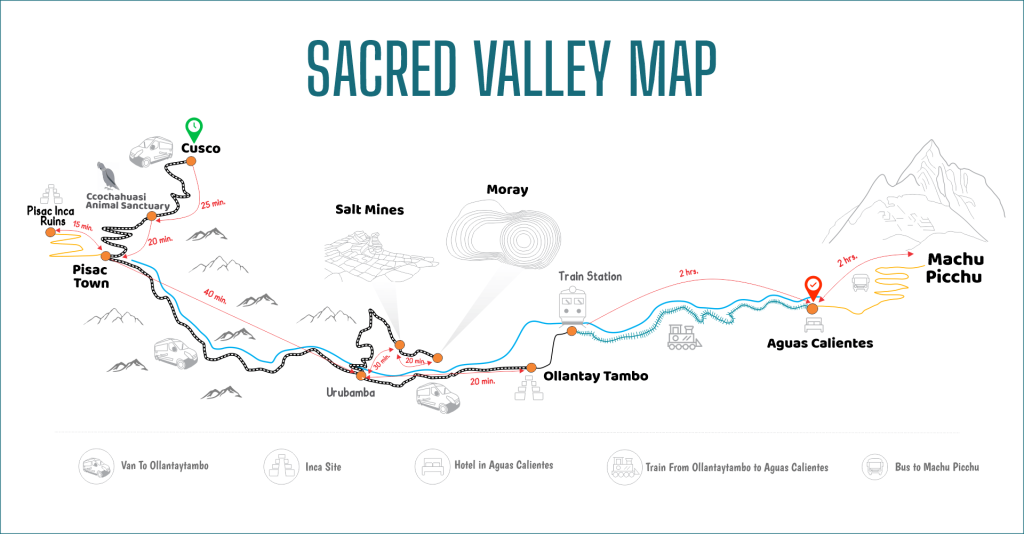
THINGS TO SEE, DO AND VISIT IN THE SACRED VALLEY
Booking a tour is a great way to spend your time acclimatizing to the elevation before endeavoring a more strenuous hike like Salkantay or the Classic Incan trail. The tour guide will pick you up at your hotel at 7:30am, with a private van and head towards the Sacred Valley of the Incas. Stopping along many of the important sites and towns along the way.
Manos de la cominidada
Manos de la Comunidad has a variety of Camelids indigenous to Peru like the llama, alpaca, guanacos and the Vicuna that produces very fine wool and can only be shorn every three years. We visit this farm to pet, feed and take pictures with these animals. Also, in the center are local women dressed in local garments, weaving items using the wool from these animals. As you exit, you will encounter a museum and souvenir shop. The workers are always around to answer any questions, but you should never feel pressured to buy anything.
Pisac
Most agencies stop first at the Mirador of Taray, where you get your first view of the valley. This spectacular view of the Urubamba valley is laid out before you, with traditional farming communities in the valley floor and mountain peaks rising from the end of the valley.
You will visit the extensive and well preserved Pisac archaeological site which overlooks the green lush valley and is the entry point to the valley. The Sacred Valley was agriculturally important to the Incas and still plays a major role in the sustenance of the Cusco region. Evidence of this can be found in the many food warehouse at the top of the hill, that were used for preservation because of the lower temperatures.
The lower you go, you find carefully engineered large farming terraces, taking advantage of the different micro climates at each level. Also present is an intricate water irrigation sytem originating from the stream uphill and supplying all the terraces below using water channels. Adjacent to the site is the biggest Inca cemetry ever found, with thousands of opening tombs decorating the montain side. It is said that if you visit these tombs, you can still find human skeletal remains inside.
Salt mines
The Salt Mine (Salineras), close to the colonial town of Maras, are Pre-Inca. Hundreds of saltpans decorate the hillside and have been used for salt extraction since before the Inca era. A natural spring at the top of the valley discharges a small stream of water heavily laden with salt, which is diverted into saltpans and evaporated to produce a salt that is of very high quality. This is one of the few places in the world where you can find naturally pink salt! The locals have full mining rights and all the salt sold on site belongs to the locals. It still supplies Peru with over 90% of its salt.
The salt mines gives you a taste of an age-old tradition, that has not changed for many generations. The people in this community have been harvesting salt for many years. It’s a rich custom and tradition that has passed saltpans from one generation to the next. This has been their main source of income and they have exclusive rights to these mines. Salineras is one of the very few salt mines left in the world to have not switched to more modern techniques. The communal company of Maras (cooparative) packages and distributes the salt and splits the profits with the families according to the number of saltpans they own. This is a great place to grab another souvenir as all the money spent goes directly to the local community.
More detailed information about the Salt mines here!
Moray
Moray, was an experimental farming site built in the form of an ampitheater with different temperatures at each level in order to grow different types of crops. It is sometimes refered to as the “Greenhouse of the Incas” because it functioned the same way a modern greenhouse would function. These levels of terraces were carved before the Incas took control of the Sacred Valley, but then used by the Incas to research optimal growing conditions for their crops. They even brought in different soil samples from other regions, to optimise their research. The locals were still using it for growing their crops, until the 1970s when it was preserved and protected for tourism
Ollantaytambo
Finally, we drive to Ollantaytambo to explore this quaint Inca village and the amazing Inca Ruins on the hilltop above. These ruins are where the Incas fought their last battle with the Spanish conquerous, before they had to retreat and flee into the dense jungle. Most of the structures were unfortunately incomplete. There is a section with a number of bolders that were carved, but didnt make it to their destination.
Another possibility, is that the battle was so intense, it caused a lot of damage to this massive Inca site. Still standing is the incredible architecture of the Sun Temple, where we can still admire the intricate water fountains, the Incahuatana and the impressive storehouses. It is believed the site initially belonged to Aymaru clan, before being taken over by the Incas. It stands as the last and best fought battle between the Incas and the Spanish. The Incas won this battle, but becuase their numbers were so depleted by the spanish flu they fleed towards the dense jungle. Most tours end here and from the top of the site, you can watch the sunset over the town and the peaceful river on your right.
Ollantaytambo holds many annual festivals, the biggest taking place in January, around Epiphany (5th January to 9th January) and Pentecost (May or June). Check online if there is anything coming up during your stay. It’s a great tourist hub, with an assortment of restaurants and accomodation establishments for all budgets. It’s the gateway to the Inca Trail or the train to Machu Picchu. Once the daily crowds disperse, you are left with a peaceful town, with many indigenous locals, that still call this small town home.
Additional towns
Chinchero
Chinchero is a small rural town between Urubamba and Cusco. It sits at an elevation of 3,762m/12,343ft. The language predominantly spoken is Quechua (82%), however most locals are bilingual speaking both Quechua and Spanish. An international airport is currently under construction, with its estimated completion date in 2026. This airport is meant to serve the millions of tourists that flock in every year heading for the nearby Seventh Wonder of the world: Machu Picchu.
There are many fun, engaging and unique things to do in town. Firstly, their Sunday market is a great alternative to the more famous market in Pisac. It tends to be more authentic and is usually less crowded. Every weekend the streets are full of celebrations of weddings and local concerts, playing local music like Huayna. The atmosphere makes you want to dance, clap along to the beat and just let go.
You can also learn to weave. The complimentary warp-face weaving technique has been practiced by the locals for centuries. The locals will teach you how they make the thread from Alpaca wool, how to dye the fabric and finally how to make the beautiful, colorful and traditional garments, the ladies and gentlemen are sporting around town. Just 3.5km out of town is Puiray Lagoon, where you can try your hand at paddle boarding. The beautiful lagoon is serene, with very little tourists around.
The most famous thing about Chinchero is the adobe colonial church found in the main plaza. This church was built upon the foundations of an Inca temple in the early 17th Century. The ceiling and walls are beautifully decorated with floral prints and religious ornaments. Some might say this church is a representation of how the Spanish managed to conquer the religious beliefs of the Incas, converting the main religion to Christianity. They are open every Sunday for mass, free of charge.
Recommended Tour to Chinchero: Tour To Chinchero, Moray And Salt Mines Half Day
Urubamba
Urubamba is the largest town in the sacred valley. It’s a commercial center and is frequented by locals from all over the Valley for their necessities. It’s central to most tours and treks around the Sacred Valley. Whether you are heading to Chinchero, Ollantaytambo, Lares Trek or Machu Pucchu, Urubamba is an ideal place stop for food because of its size and location. It has many restaurants with international and local fusion.
Recommended Tour Operators for the Sacred Valley
SAM Travel Peru
SAM Travel Peru (10 years in business) is a highly professional tour & trekking company that focuses on treks and tours for travelers of all ages, making sure everyone has the best possible experience. A key feature offered by SAM Travel is their small tour group sizes and personalized service. They never exceed ten trekkers per group, unlike many operators who will happily reach the maximum group limit of 16 or more people. They work with each group to personalize their tour if needed. One size does not fit all. What’s more, the company’s Peruvian owner, Saul Alvarez, has been working along the Inca Trail since the age of 18, as a porter and later as a guide. He understands trekking better than most and the needs of the hiker. Please check all of its great reviews on TripAdvisor.
Website: https://www.samtravelperu.com/

Orange Nation Peru
For a while, this relatively new start-up company has been on our list of Inca Trail tour operators to consider. The company focuses on quality treks and tours for those that are budget conscious. The company tour guides, porters and cooks have shares in the company, and earn a fair amount for their level of contributions. When you choose this company, you make a direct impact to all the lives of the people that make your adventure memorable. The company has also has plenty of excellent reviews on TripAdvisor. This is definitely, one to consider.
Website: https://www.orange-nation.com

Spider Travel Peru
Spider Travel Peru is a new innovative professional adventure travel company and Inca Trail Operator that offers unparalleled experiences to unknown and untouched wilderness areas. Spider has adventure treks that are carefully designed to cater to all of the possible options its clients might desire. Its passions are sharing the incredible landscapes of the Andes and the history and culture of the Inca people! Make sure you consider its many options!
Website: https://www.spidertravelperu.com/

Glamping Peru Treks
Glamping Peru Treks creates treks and tours that offer unsurpassed luxury and comfort while hiking off the beaten track. All accommodations, food, and services are of the highest quality and standards. If you are looking for something upscale and luxurious while trekking or touring, this is the absolute best option for you. Do not be afraid to work with their service operators to create your dream personalized luxury trek or tour. The company group size averages 2 to 4 people, not exceeding 8 people. If you love your privacy, be sure to ask for a private tour.
Website: https://www.glampingperutreks.com/

Travel Tips
Planning Ahead
Traveling to the Cusco and Sacred Valley region in the high season (June, July, August) requires months of advanced planning because services fill up quickly. Trip logistics include airfare, hotel reservations, tours, and train tickets and entrance tickets if you go to Machu Picchu. Limited permits for hiking the Inca Trail to Machu Picchu can book up 4 months in advance. Note that the Inca Trail is closed each February for maintenance.
Packing List
Clothing: The weather in the Sacred Valley changes quickly, so bring a lot of layers to be prepared. Pack t-shirts and add warmth with long-sleeve clothing and a fleece jacket. Lightweight pants for trekking.
Footwear: Comfortable hiking boots or athletic sneakers with good traction are ideal for walking up to and around the Inca archaeological complexes. If enduring multi-day hikes you will definitely want boots with ankle support.
Sun protection: Don’t forget your hat, glasses, and sunblock for sun protection.
Day excursions: Bring a daypack with snug straps to carry your water, camera, and other personal belongings.
Rainy season: During the rainy season months, pack a waterproof jacket or a travel-size umbrella. Plastic ponchos are also available to buy in Cusco and the Sacred Valley.
Altitude Sickness
Altitude sickness is a common health concern for travelers planning a trip to the Sacred Valley region. Most visitors will only experience minor symptoms (shortness of breath, headache, nausea) as a result of the elevation. Take it easy the first couple days while you acclimatize and don’t overexert yourself. Towns in the Sacred Valley are actually lower in elevation than Cusco, so some travelers actually plan to spend their first few nights in the valley to reduce the onset of altitude sickness symptoms.
Transport Around the Sacred Valley
The majority of tours to the Sacred Valley include transport to/from your hotel. For independent exploration, you can take a local bus (the most economic way) or hire a taxi (more convenient and time efficient). The railway also runs between Cusco (Poroy Train) to Ollantaytambo in the Sacred Valley and then onto Aguas Calientes, the town at the base of Machu Picchu.
Money
Peruvian currency (called soles) is used to pay for taxi rides, small purchases, and tips for guides and porters. As of March 2024, $10 USD is roughly 38 Peruvian soles.
It’s good to carry around small bills and coins in the Sacred Valley because small market vendors and stores may not have adequate change to break larger notes.
You’re more apt to get better exchange rates in Cusco than in small Sacred Valley towns. There are ATMs in Pisac, Urubamba, and Ollantaytambo that dispense both US dollars and local currency.
Luggage Restrictions for Train to Machu Picchu
If you’re taking the train to Machu Picchu or doing a multi-day trek, then you’ll likely need to store your heavy luggage (aka the items you don’t need) somewhere. Each train passenger is permitted one bag or backpack weighing up to 11lbs (5kg). Fortunately, all of our recommended hotels in the Sacred Valley and Cusco provide free luggage storage for their guests.

